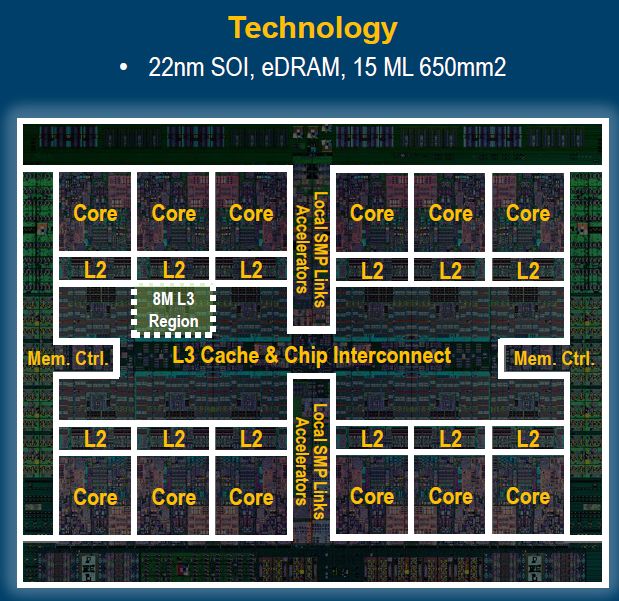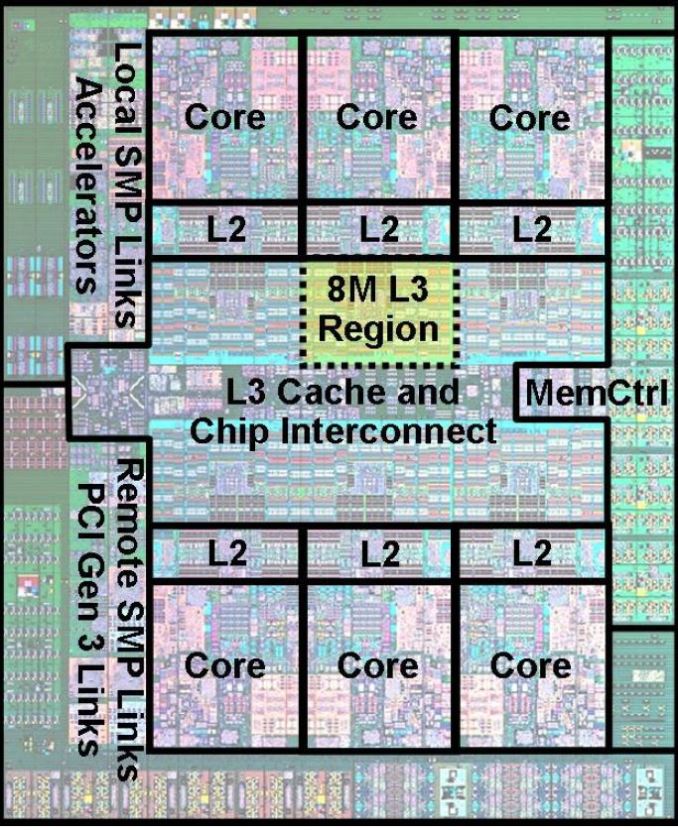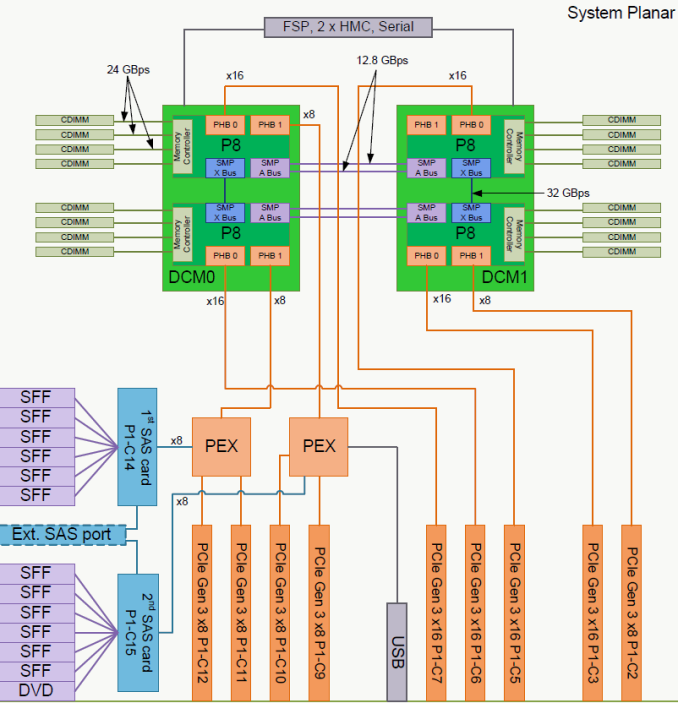The IBM POWER8 Review: Challenging the Intel Xeon
by Johan De Gelas on November 6, 2015 8:00 AM EST- Posted in
- IT Computing
- CPUs
- Enterprise
- Enterprise CPUs
- IBM
- POWER
- POWER8
Inside the S822L: Hardware Components
The 2U Rack-mount S822L server contains two IBM POWER8 DCM sockets. Each socket thus contains two cores connected by a 32GBps interconnect. The reason for using a Multi-Chip-Module (MCM) is pretty simple. Smaller five-to-six core dies are a lot cheaper to produce than the massive 650 mm² monolithic 12-core dies. As a result the latter are reserved for IBM's high-end (E880 and a like). So while most POWER8 presentations and news posts on the net talk about the multi-core die below...
... it is actually an MCM with two six core dies like the one below that is challenging the 10 to 18 core Xeons. The massive monolithic 10-12 core dies are in fact reserved for much more expensive IBM servers.
The layout of the S822L is well illustrated by the scheme inside the manual.
Each DCM offers 48 PCIe Gen 3 lanes. 32 of those lanes are directly connected to the processor while 16 connect to PCIe switches. The PCIe switches have "only" 8 lanes upstream to the DCM, but offer 24 lanes to "medium" speed devices downstream. As it unlikely that both your SAS controllers and your network controllers will gobble up the full PCIe x8 bandwidth, this is a very elegant way to offer additional PCIe lanes.













146 Comments
View All Comments
JohanAnandtech - Saturday, November 7, 2015 - link
Ok, Europe adopt the dot, but maybe the US can adopt the metric system like the rest of the world? :-)bitaljus - Saturday, November 7, 2015 - link
or better yet recode this site to see from what country u are visiting and use the appropriate denote thousands symbol, appropriate metric system and even time for the viewer. how meany time i was irradiated when i need to google something like this just to make it in local. and this is easy to do in the site natively. (P.S. Sorry for bad English, not native)nils_ - Wednesday, November 11, 2015 - link
The browser already sends a header with Accept-Language, which should be the preferred way to for the web site to determine locale. For example, I live in Germany so my browser will send en, en_UK, en_US, de and DE (this can be set somewhere in the settings). Now you can determine the language and other localisation based upon that, and there are tools where you can set the locale to then display dates, times etc.. based n that.Many sites instead use Geolocation based on the IP address, which can be really awkward when you travel to a country where you can't read the language.
ZeDestructor - Saturday, November 7, 2015 - link
Even within EU it's not consistent.. UK uses commas for thousands, dot for decimal (and that's why the US and most anglophone countries use the same setup), Germany, Netherlands and France on the other hand favour dots for thousands, commas for decimal, so you see it used there.. and in a great number of their former colonies where the language and culture has stuck.nils_ - Wednesday, November 11, 2015 - link
Dates / Time are even funnier, that's also extremely inconsistent and can be very misleading. Think for examle a date like 12/11/2015, in some countries it'll mean the 12th of November while in others it will mean the 11th of December, and sometimes even the 2015th of November in 11 AD ;)I remember reading on the GTA IV in-game "Internet" a travel guide to Europe that said the months here have 12 days but there are 30 months a year or something to that effect ;)
powchie - Friday, November 6, 2015 - link
let Johan do more reviews. been reading his stuff from late 90's and consider him the best then followed by Anand.Ryan Smith - Saturday, November 7, 2015 - link
Trust me when I say that if I could whip Johan any harder and make him work any faster I would be doing just that.;-)juhatus - Saturday, November 7, 2015 - link
When the Balrog showed up for work he had everyone fired.ruthan - Friday, November 6, 2015 - link
In summary should be something about software support, raw power is here, but software stack isvery limited.
PowerCPU is good for old legacy apps - SAP, Oracle etc.. but otherwise its dead end.
I would like to see comparision of IBM LPAR virtualization against Xeon Vmware solution, or Oracle / MySQL benchmark on power vs. Oracle benchmark on Xeon.
Server with Power even cant to run Crysis, or maybe some QEMU magic..
ruthan - Friday, November 6, 2015 - link
Pleas Ad edit button like other civilized sites, i was hurry when i wrote it.